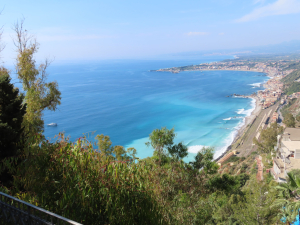
View of the coastline from Parco Florence Trevelyan, the public gardens that began as a private park.
In Part 1, we survived an arduous journey to Taormina for the first leg of our two-week Sicily-Southern Italy tour. We learned about the city’s discovery, its shames (eliminating Jews), and folklore stories woven into today’s culture, from pinecones to pottery heads of planted basil.
what we did:
At the top of the pedestrian-only hill from our hotel, Eurostars Monte Tauro, is the serenely peaceful Parco Florence Trevelyan. The beautiful public gardens were originally created as a private park by Lady Florence Trevelyan Cacciola, a Scottish noblewoman married to the mayor. She styled her sanctuary as a typical English garden with an infusion of colorful varieties of flowers and plants from all over the world, but it was her passion for ornithology (bird watching) that inspired many of the park’s fanciful brick structures. The one most used as a backdrop for photos is called “The Beehives”. Taormina’s government now maintains the quiet manicured respite overlooking Mt. Etna and the coastline.
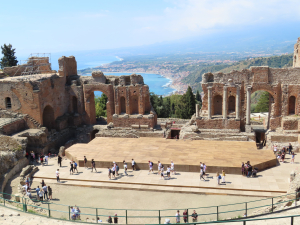
Teatro Antico de Taormina is carved into the mountain in Taormina, Sicily.
Long before the Romans came to Taormina, Greeks occupied the area. One of the preserved architectural structures they built was Teatro Antico di Taormina, an amphitheater carved into Mount Tauro during the third century before Christ. It was the second largest theater ever built in Sicily. Local limestone blocks were set in a semicircle, with nine sections. As the Greeks cherished plays, they set the staging and backdrop columns so that Mt. Etna and the Calabrian coastline would be clearly visible from even the cheap seats. Emperor Constantine had a different use for the space when the Romans took over. As our tour group walked carefully along restored but still uneven steps or viewed crumbling remains of columns and the lower-level orchestra staging area, it’s not difficult to imagine that long after gladiator games ceased, the amphitheater was abandoned. Bricks were scavenged for other buildings. All is not lost though. Originally, Teatro Antico di Taormina held about 10,000 people. After WWII, the government began rebuilding and restoring. Today it holds about 5,000 for concerts and plays produced May through mid-September.
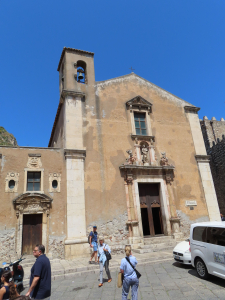
The Church of Saint Catherine was built on the ruins of the Odeon.
On our guided tour of the city, we stopped at the Church of Saint Catherine. It was built on the ruins of the Odeon in Baroque style. A statue of her holds a sword in her right hand. This earmarks her Catholic faith that defeats death, destruction and evil.
The beach area at Taormina is very different from any I’ve seen. In Coney Island, NY where I lived part-time as a youth, the beach meant tiptoeing from blanket edge to blanket edge to avoid stepping on people. In Florida, our beaches are often written up as some of the best in the world for soft white sand. In Taormina, you first must either descend many, many stairs or take the Funivia Cableway Taormina to reach the beach. Ahead of the rocky strip stood barge-like structures on which hundreds of chaise lounges were lined up and rentable for anyone wanting to sunbathe.
With our friends we each paid the 3 € fee to ride down on the cable car. At the time of our trip, Italy still required masks on any transportation. We were literally pushed into an overcrowded cable car than we would not have liked even before COVID. The cable car uncomfortably creaked, groaned and jiggled. Once out, we crossed to a long set of stairs leading to the beach and to our destination, the tiny island of Isola Bella. This was not a straight, walk-along-the-shoreline stroll.
The rocky beach narrows and we went up and down stairs to progress. People sprawled on towels or gingerly walked on the rock-strewn sand. Fully clothed and hatted women stopped us every few feet to ask if we’d like a Thai massage for our feet, head, neck, or back. We just couldn’t figure out where one would comfortably sit to get relaxed!
The climb down the stairs was not as difficult as the long climb back up, but by now we had our stair-stepping legs beneath us and bounded off in search of Russ, who given up the walk and parked himself at a seaside table in front of the luxury hotel, Grand Hotel Timeo, A Belmond Hotel, Taormina. A glorious setting that made us feel like aristocrats on the Grand Tour! Glasses of local wines ran an average of 25€, but our solicitous server brought us platters of potato chips, olives, and almonds to munch on while we sipped, chatted, and counted our blessings for the blue skies and fair temperature.
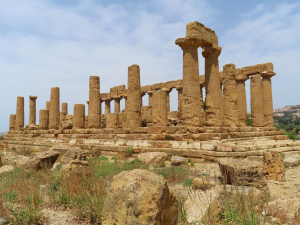
These are the ruin of the Roman Temple of Hera Lacinia.
A wonderful group day trip began at the Valley of the Temples at Agrigento, a UNESCO site dating back to Greek rule in 5th century BCE. The Valley of the Temples originally had 21 temples, but only 10 have been uncovered. Some apparently became used as quarries, scavenging the stones for use elsewhere. The temples formed a crown around the city. Temples were built in relationship to the surrounding land. Romans were more concerned with the interior design, so theirs are rectangular. Greeks preferred round temples modeled after women’s wombs.
The temple that survived the best is the Temple of Concordia, which had been converted to a basilica. That may have aided its preservation, as well as not being damaged by war or volcanos. This is the only place in the world where you can find this many Greek temples (seven in a row) situated. They were always above ground so didn’t need to be excavated.
When we first approached the area on foot, I noticed star-shaped white and yellow flowers growing on a single stem and branching tall spikes. They are called asphodels and are found “where gods live”. They are frequently found in areas associated with the underworld, where gods were reputed to hover between the realms of life and death.
Reconstruction of Concordia began in 1740, although thanks to a Latin author’s bad penmanship, it was incorrectly assumed to be dedicated to Juno/Hera. You can still see the 10 steps leading down to the monumental altar where sacrifices took place. Columns were built in Doric style of calcarenite stone. The Temple of Concordia owes its name to a Latin inscription with a dedication to “the harmony of the people of Agrigento”. Between 2000 and 2006, restorations were done to stabilize the building and conserve the stone blocks.
Unlike temples in Greece that were composed of white marble, these were built of limestone and coated to appear white. Greeks venerated statues for what they represented. Doric columns made temples seem more monumental. Greeks believed fame gave them immortality. Art could be destroyed, but poetry could live forever, so that’s what they favored.
Prickly pear plants scatter across the area. Spaniards introduced them in the 1700s. Now the plant fruit and stems are used for tea and jams.
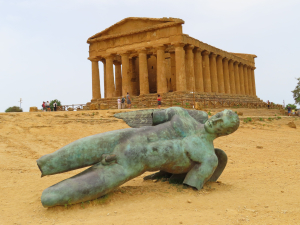
The fallen statue of Icarus lays in front of the Temple of Concordia, the most preserved of all the discovered temples.
The largest statue we saw was in front of the Temple of Concordia of a fallen Icarus, who mythology credits with flying too close to the sun. Donated by Polish sculptor Igor Mitoraj in 2011, he said it represents man dying while searching for freedom. Mitoraj died in 2014.
We did visit a museum following lunch to learn more about the temples, but after our large and scrumptious lunch at Il Re di Girgenti (read below in where we ate:) all most of us wanted to do was nap!
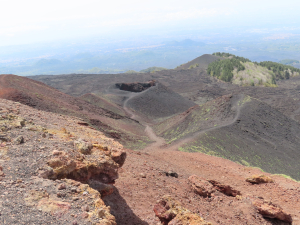
Looking down the valley from Mt. Etna at 6,600′.
A week after our visit to Mt. Etna we learned the effusive volcano had erupted. The day we visited was blue skies and little wind. As our bus wound up the mountain as far as it could travel to the 6,600’ plateau where a restaurant, parking lot, and various vendors sold their wares, we learned there are three paths one could take to explore the lava-strewn landscape. Part of the decision lies with how much time you want to spend, how physically fit you are, and just how steep a path you want to traverse. From any of them, you can see the red roofs of the city below.
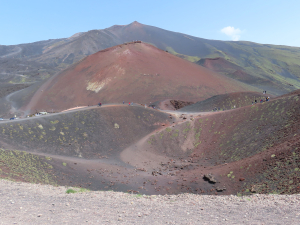
You have a choice which trail to follow up Mt. Etna.
Mt. Etna was our destination, but I enjoyed the journey getting there. I loved the profusion of lemon and orange orchards greening the lower valley. In 1929 an eruption buried a whole village of about 3,000 people. Everywhere we’ve traveled in the Catania region, the buildings look weathered as if storms had beaten them mercilessly, but none more so than those that have survived Mt. Etna’s blasts of soot and ash. Paint colors are faded and have peeled or stained in splotches, but energy juts out defiantly from the people and rich earth-tone colors of the environment. Bright yellow blooms blanket the ground. Wildflowers like saponria bloom later in the year. We see more of them the higher we climb and the cooler the air is. Gorse bush’s flowers (fragrant shrubs) grow rapidly on the lava soil.
Because of past eruptions, the highest elevation where people can reside is at 3,000’. The forested area of the mountain sits about 7,000’ and above that, it evokes a desert. In 1987, local government took over maintenance of Etna Regional Park. As we wound our way carefully up to the 6,600’ parking area, we stopped to adjust our bodies to the higher altitude and to take a bathroom break in Zafferana Etnea, a prosperous community in the Metropolitan City of Catania with about 10,000 people. The streets are paved with lava stone. There are few places to use a toilet that are free. Typically, one goes to a bar (a bakery or takeout sandwich place) or you pay a fee to use their private toilet. Our thoughtful Tour Director Andrea F. bought us the local treat, crocanolo al pistachio, a thin, crisp cookie chock full of pistachio pieces.
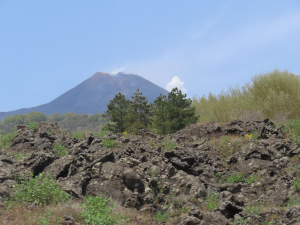
The view of Mt. Etna as we wound our way up and down the steep road.
More than 100 beekeepers are in this area, with chestnut honey being the one most produced as chestnut trees are prevalent. We heard that in Saint Alfio there is a chestnut tree which is between 2000 and 4000 years old, according to botanists. It is considered the oldest tree in all of Europe. Chestnut trees thrive higher than 1,000’. They flower in August and by October/November are ripe to harvest. Many are edible. The wood from the trees is used for furniture, doors, and wine barrels.

Trattoria Tutti Cca tables sit on the L-shaped staircase.
where we ate:
Our friends Dave and Vivian W knew someone who frequented Taormina so our first night of personal dining was on his friend’s recommendation. Everyone should be so fortunate. Trattoria Tutti Cca is unique in more ways than the menu. Tables were set against the far right and far left of an ascending stone staircase that took a curved left L up, at which point most of the outer wall disappeared and our view overlooked the ruins of a partially excavated Roman theater. Trattoria Tutti Cca has a small indoor dining room, but the night air was balmy, and we were celebrating friendships and being on this trip together. (We had become friends on an Odysseys Unlimited trip to Norway and Denmark* and had planned this trip together for at least a year.)
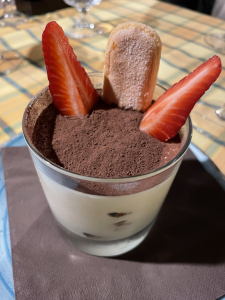
Tiramisu at Trattoria Tutti Cca was creamy.
We were early for the typical late-dining crowd, so when the trio of musicians began to serenade, their attention focused on us. The evening sky drew a curtain around the ruins. Our waiter, studying to be a sommelier, recommended Planeta ‘s Santa Cecilia Docnoto, 2015. Smooth wine with a long finish. I had gnocchi with a buttery sauce, pistachio grains, and prawns. We ordered a side of roasted potatoes for Russ’ schnitzel-type chicken, which was a generous platter of well-seasoned potatoes. Our waiter said their tiramisu was the best in the area (a favorite of Dave’s and mine), so of course, we had it. Two enormous spears of strawberry and a biscotti cookie missed a dousing by the dark cocoa dusting the pudding.
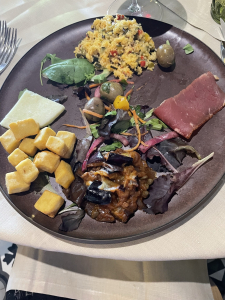
Appetizer platter at Il Re di Girgenti had soft potato cubes, stewed eggplant, olives, salad, ham and couscous.
After walking around the nearby Valley of the Temples, we were hungry for a four-course treat at Il Re di Girgenti. No way even at that could anyone have eaten all of the food served. First course was an individual platter of soft potato cubes, stewed eggplant, olives, salad, ham, and couscous. Next was the requisite pasta dish, but this one had ground almonds and pistachios, which gave a light crunch to every bite. Third course was a thick round portion of braised pork that had been marinated in a local red wine and served atop mashed parsnip. For dessert, as if we needed more food, we had a Chinese mandarin granita. No idea what the white wine drinkers had, but the red Bagliesi Scialusu, a local Sicilian wine, complimented the food well.
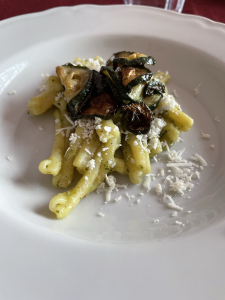
Busiate (coiled) pasta with sauteed zucchini bits and kissed by grated, salted ricotta at Agriturismo San Leonardello.
After visiting Mt. Etna on that day tour, we stopped for lunch nearby at Agriturismo San Leonardello, a farmhouse surrounded by an historic biological citrus garden of kiwi and lemon groves. The soil is enriched from lava flows. The farm also offers lodging. I’d recommend this restaurant to anyone. We were served hand-sized appetizer portions of piping hot calzones, a pillowy crust stuffed with fresh creamy ricotta, and a platter artfully arranged of green olives, cheese triangles, a slice of mortadella, tomato bruschetta on fresh bread, and a tablespoon helping of stewed eggplant. The second course was homemade busiate coiled pasta with sauteed zucchini bits and kissed by grated, salted ricotta. Dessert was Biancomangiare, a silky-smooth Sicilian almond milk pudding topped by chopped pistachios.
Our last evening in Taormina, a group of us met for dinner at Trattoria Il Bacchanali restaurant. Café tables stretched to the walkways. Service was good.
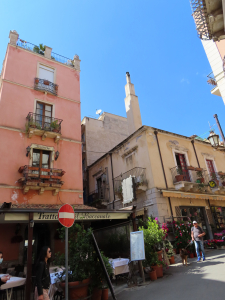
Trattoria Il Bacchanali gave us the chance to people watch.
Once again, we were blessed with perfect weather and a roving band of musicians who serenaded us. I had four slender lamb chops and a spinach dish that arrived with sauteed eggplant and shredded carrot salad. Russ had spaghetti bolognaise and Sicilian sausages. Our tour friends had different dishes, but we all thought the food tasty and the prices reasonable. We have found all the Taormina restauranteurs eager to please and to go beyond what is expected. Our servers gifted us with fresh handmade almond biscotti and a glass of almond wine. It’s the second glass of complimentary local almond wine (ala a liquor) that we’ve been given at the end of the meal, but this one was much darker in color and more syrupy-thick compared to the other.
We leave for Italy’s mainland tomorrow.
In Part 3: TRAVELER DISCOVERIES OF SOUTHSIDE ITALY’S ANCIENT ORIGINS, the tour continues to Matera, where people lived in caves for at least 7,000 years.
*DENMARK & NORWAY: ROYALLY RICH IN BREATHTAKING BEAUTY, FROM CASTLES TO FJORDS, https://karenkuzsel.com/2017/09/20/denmark-norway-royally-rich-in-breathtaking-beauty-from-castles-to-fjords-5/
www.eurostarshotels.co.ukeurostars-monte-tauro.html
https://www.facebook.com/trattoria.tutticca/
https://odysseys-unlimited.com
Karen Kuzsel is a writer-editor based in the Orlando area who specializes in the hospitality, entertainment, meetings & events industries. She is an active member of International Live Events Association and Meeting Professionals International and is now serving on the 2021-2022 MPI Global Advisory Board for Small Business Owners. She is a member of the Society of Professional Journalists. Karen writes about food & wine, spas, destinations, venues, meetings & events. A career journalist, she has owned magazines, written for newspapers, trade publications, radio and TV. As her alter-ego, Natasha, The Psychic Lady, she is a featured entertainer for corporate and social events. Karen@KarenKuzsel.com; www.KarenKuzsel.com; www.ThePsychicLady.com; @karenkuzsel; @thepsychiclady. Food photos for this series by Karen Kuzsel. All other Photos by Russ Wagner, a retired government planner/builder who has a passion for historic architecture, wine, trains, travel and taking photographs.
